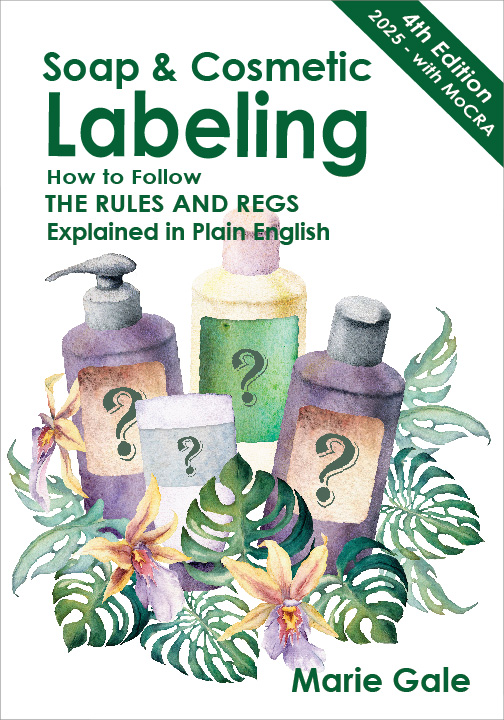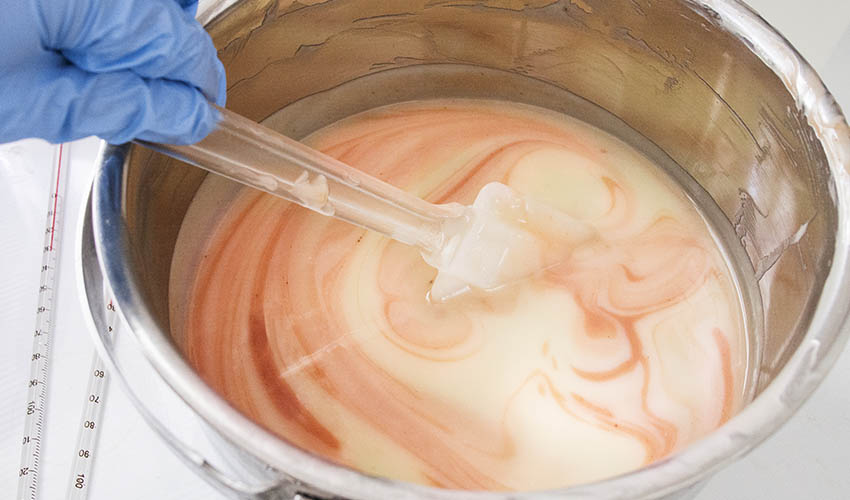If you are familiar with basic soap chemistry, you know that when oils, fats, or butters are mixed with sodium hydroxide or or potassium hydroxide (lye) it results in a chemical process called saponification and the result is soap (and glycerin).
If you are familiar with the basic rules for the ingredient declaration on a cosmetic label, you know that you can list what goes INTO the soap pot, or what comes OUT of the soap pot. You probably also know that the correct, accepted name should be used for each ingredient.
So what do you call unsaponified oils?
OUT of the Soap Pot
What comes OUT of the soap pot is kind of tricky because the chemical reaction of saponification created some NEW things that didn’t exist when the individual items were poured INTO the pot.
— Glycerin
The glycerin is separated from the oils/fats/butters during the saponification process, so it comes out of the pot as its own self, glycerin. It should be listed in the ingredient declaration as “glycerin.” The amount of glycerin is relative to the amount of lye; the formula for figuring this out is contained in my recent post on Glycerin.
— Saponified Oils
Of course, there are the saponified oils which make up the bulk of what comes out of the pot. They are also a new thing and should be listed in the ingredient declaration by their correct chemical name (see the list below).
— Unsaponified Oils
Aahhh, but what about the UNsaponified oils? These come about because of the “superfat” or “lye discount” used, either for safety or to make the soap more moisturizing. How do you know what these unsaponified oils are, and how are they listed in the ingredient declaration?
The first thing to know is that they probably aren’t whole oils any more. Some of the fatty acids have been saponified into soap, and some haven’t. To complicate matters, they could be complete oil molecules (tri-glycerides) or they could be broken down and be di-glycerides (two fatty acid chains) or even mono-glycerides (one chain). There’s no way to know.
Luckily, there is a name for that in the cosmetic ingredient dictionary – glycerides. But it has to specify which oil the glycerides are from.
The following table lists the correct name for the saponified oil (using sodium hydroxide) AND the correct name for the unsaponified glycerides, for most of the more common oils used in soapmaking.
| Oil/fat/butter | Saponified | Unsaponified |
| Coconut oil | Sodium Cocoate | Cocoglycerides |
| Olive Oil | Sodium Olivate | Olive Glycerides |
| Palm Oil | Sodium Palmate | Palm Glycerides |
| Palm Kernel Oil | Sodium Palm Kernelate | Palm Kernel Glycerides |
| Shea Butter | Sodium Shea Butterate | Shea Butter Glycerides |
| Lard | Sodium Lardate | Lard Glycerides |
Using some basic math, you can actually calculate the percentages of each saponified oil and oil glycerides in the final bar. Well, probably close enough to create an accurate ingredient declaration!

Shameless plug!
To really be able to create your own labels that comply with the regulations, get my book from Amazon and use it.
4th Edition – Released March 5, 2025!!!
Or order directly from me (and get a signed copy)!
INTO the Soap Pot
Listing what goes INTO the soap pot is pretty straightforward. Easy, in fact. Just list all of the ingredients that you measured and put into the pot! The name to use is the common English name (for BOTANICALS) and the chemical name (for everything else). You should be able to get these names from your supplier. And, of course, all of the components of any blended ingredients you use, such as color additives or preservatives.


Leave a Reply